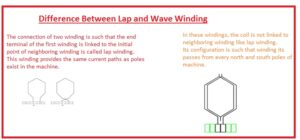 Hello, friends, I hope you all are doing great. In today’s tutorial, we will discuss the Difference Between Lap and Wave Winding. The winding wounded at the armature is called armature winding. The armature winding is used to the conversion of power for generator mechanical power is transformed in the electrical power and for motor electrical energy is transformed in the mechanical power. There are 2 common types of armature windings first one is lap windings and the second one is wave winding.
Hello, friends, I hope you all are doing great. In today’s tutorial, we will discuss the Difference Between Lap and Wave Winding. The winding wounded at the armature is called armature winding. The armature winding is used to the conversion of power for generator mechanical power is transformed in the electrical power and for motor electrical energy is transformed in the mechanical power. There are 2 common types of armature windings first one is lap windings and the second one is wave winding.
The basic difference between these two windings is that in the lap winding end of every coil is attached with the neighboring point and in wave winding the endpoint of winding is connected with the point at some distance. In today’s post, we will have a detailed look at both lap and wave winding with the detailed compare them to find their differences. So let’s get started with Difference Between Lap and Wave Winding.
Difference Between Lap and Wave Winding
Lap Winding
- The connection of two winding is such that the end terminal of the first winding is linked to the initial point of neighboring winding is called lap winding.
- This winding provides the same current paths as poles exist in the machine.
- The main types of lap winding are simplex, duplex.
- It has a number of brushes equal to parallel current paths.
- The simplex winding has a parallel path same ot poles.
- Lap windings of multiplex type used for high current applications.
- Lap winding is employed for large current and less voltage applications.
- It is expensive than wave winding since more conductor is used
Simplex Lap Winding
- This winding has a number of parallel paths equal to the number of poles.
Duplex Lap Winding
- In this windings number of the parallel paths is 2 times the poles of machines.
What is Wave Winding
- In these windings, the coil is not linked to neighboring winding like lap winding.
- Its configuration is such that winding its passes from every north and south poles of machine.
- This winding called series due to sequence structure
- There is just a need for 2 brushed in this winding
- It has only two parallel paths
- Using Z/2 formula number of the conductor can be determined
- Its common types are progressive and regressive wave winding
- These windings need dummy winding to fulfill the requirements of condutor used in this winding
So friends that is a detailed post about the difference between lap and wave winding. If you have any query ask in the comments. Thanks for reading. Have a good day.







